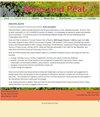Mid-to late holocene elemental record and isotopic composition of lead in a peat core from Wolbrom (S Poland)
IF 1.5
4区 环境科学与生态学
Q4 ENVIRONMENTAL SCIENCES
引用次数: 0
Abstract
Peat Core W3 was taken from the fen in Wolbrom (Silesian-Cracovian Upland, Southern Poland) in September 2015. Previous analyses of Core W3 showed a significant increase in lead concentration during the time of the Roman Empire as well as some changes in peat accumulation conditions. The work reported here investigates its geochemical composition in terms of major and trace elements (Pb, Zn, Na, K, Ca, Fe, Mg, Mn, Cu, Ni, Cr by AAS) as well as Pb isotopic composition, to identify the sources of metal pollution in the Wolbrom peat deposit. The geochemical record spans the period from 4900 BC to modern times, with a likely hiatus corresponding to the period from the Middle Ages to the beginning of the contemporary metallurgical industry. The Pb isotopic composition combined with a cluster analysis allows identification of the primary sources of Pb. In addition, Principal Component Analysis (PCA) helps to decipher the most important factors that affected the chemical composition of sediments at Wolbrom. These factors were linked to chemical denudation and human activity.波兰Wolbrom泥炭岩心全新世中晚期铅元素记录及同位素组成
泥炭芯W3于2015年9月在Wolbrom (Silesian-Cracovian高地,波兰南部)的沼泽中拍摄。先前对W3岩心的分析表明,在罗马帝国时期,铅浓度显著增加,泥炭堆积条件也发生了一些变化。利用原子吸收光谱法(AAS)研究了该泥炭矿床主微量元素(Pb、Zn、Na、K、Ca、Fe、Mg、Mn、Cu、Ni、Cr)的地球化学组成和Pb同位素组成,以确定其金属污染源。地球化学记录的时间跨度从公元前4900年到现代,其中可能有一个间歇期,对应于中世纪到当代冶金工业开始的时期。结合聚类分析的Pb同位素组成可以确定铅的主要来源。此外,主成分分析(PCA)有助于破译影响Wolbrom沉积物化学成分的最重要因素。这些因素与化学剥蚀和人类活动有关。
本文章由计算机程序翻译,如有差异,请以英文原文为准。
求助全文
约1分钟内获得全文
求助全文
来源期刊

Mires and Peat
ENVIRONMENTAL SCIENCES-
CiteScore
2.30
自引率
16.70%
发文量
0
审稿时长
33 weeks
期刊介绍:
Mires and Peat is a peer-reviewed internet journal focusing specifically on mires, peatlands and peat. As a truly “free-to-users” publication (i.e. NO CHARGES to authors OR readers), it is immediately accessible to readers and potential authors worldwide. It is published jointly by the International Peatland Society (IPS) and the International Mire Conservation Group (IMCG).
Mires and Peat is indexed by Thomson Reuters Web of Science (2017 Impact Factors: 1.326 [two-year] and 1.638 [five-year]), Elsevier Scopus, EBSCO Environment Complete, CABI Abstracts, CSA Proquest (including their Aquatic Science and Fisheries Abstracts ASFA, Ecology, Entomology, Animal Behavior, Aqualine and Pollution databases) and Directory of Open Access Journals (DOAJ). Mires and Peat also participates in the CABI Full Text Repository, and subscribes to the Portico E-journal Preservation Service (LTPA).
Mires and Peat publishes high-quality research papers on all aspects of peatland science, technology and wise use, including:
ecology, hydrology, survey, inventory, classification, functions and values of mires and peatlands;
scientific, economic and human aspects of the management of peatlands for agriculture, forestry, nature conservation, environmental protection, peat extraction, industrial development and other purposes;
biological, physical and chemical characteristics of peat; and
climate change and peatlands.
Short communications and review articles on these and related topics will also be considered; and suggestions for special issues of the Journal based on the proceedings of conferences, seminars, symposia and workshops will be welcomed. The submission of material by authors and from countries whose work would otherwise be inaccessible to the international community is particularly encouraged.
 求助内容:
求助内容: 应助结果提醒方式:
应助结果提醒方式:


